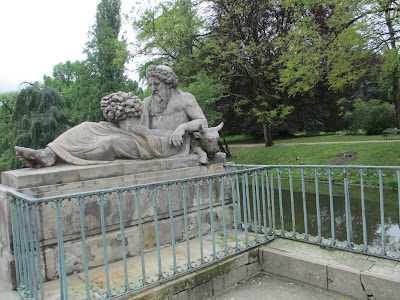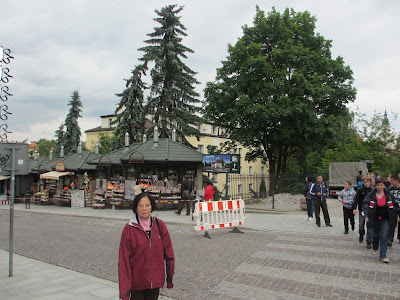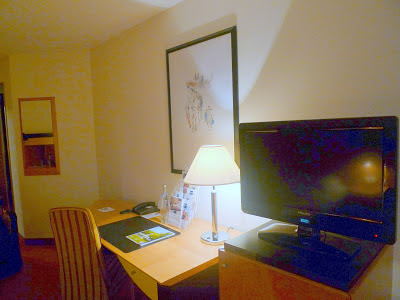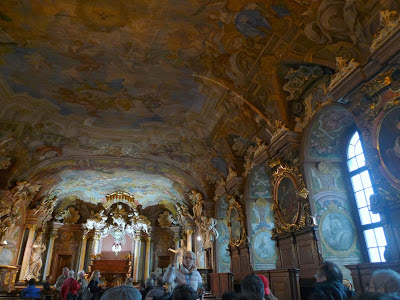Eastern Europe: A trip to popular sights and hidden attractions
as recounted by S. L. Lim
I packed and unpacked the hand luggage, still undecided as to which jacket I should take for my ten day trip to Eastern Europe. It was the 24th of May, the beginning of summer, but the weather report for the week stated that the temperature in Warsaw would be between 10 C and 26 C. At the eleventh hour I opted for the thicker, but much bulkier jacket. I was glad I made the decision, as the moment we landed at Frederic Chopin Airport in Warsaw, our tour group was greeted by a gust of cold wind that made me shiver.
A coach was already waiting to take us to our first destination.
Warsaw
A camera clicked and I got the first snapshot of the tour.
Oops! Not too good.
.
Ah, this one is better.
And here are more views of Warsaw as seen through the windows
of the moving coach.
We arrived at Warsaw Lazienki Park and the Royal Garden.
And as we stood to admire a statue, I could feel the piercing cold, although garbed under layers of warm clothing.
Despite the bitter cold and discovering that the Royal Lazienki Museum was closed for the day, we were keen to see the park.
One of the main attractions in the park was Chopin Monument
which was bordered with lush greenery.
Another attraction in the park was the Palace On Water which stands on an artificial island in a man-made lake
with fountains that spouted water high into the crispy air
and ducks that glided gracefully on the tranquil water, unperturbed by the presence of tourists strolling by.
And elsewhere, flowers in a profusion of colours provided a feast
for the eyes.
We paused to gaze at and contemplate on the many statues that graced the ground.
Our next destination was Warsaw Old Market Square which is situated in the heart of the Old Town. The Square must be a popular tourist spot as groups of camera-toting tourists were already busy taking pictures of the Warsaw Mermaid monument (a mythical protector of the city) and the surrounding buildings.
Others were happy just to linger in the square, admire the architectural styles of the surrounding buildings or relax in the open terrace cafes while soaking in the atmosphere.
After the long walk in the cold, it was a welcome relief when we were finally allowed to return to the warmth and comfort of our hotel rooms.
Czestochowa/Krakow
En route to Krakow we made a brief stop at the town of Czestochowa.
We followed behind the footsteps of our tour guide who led us down a narrow road to Jasna Gora Monastery.
Other tourists, worshipers and pilgrims too could be seen making their way to the shrine of the Virgin Mary.
At the entrance to the monastery we jostled our way through the bustling crowd.
A feisty and jovial nun, who conducted the tour, greeted us and showed us how to elbow our way through the teeming crowd.
Her comical demonstration left most of us smiling and laughing and I could not help suppressing a smile as it reminded me of the movie, Sister Act.
She was soon flitting around the church which housed the Black Madonna, explaining and telling interesting anecdotes about the miraculous painting.
One was about the story of a thief who tried, but failed to steal the painting as each time he loaded the painting onto his cart , it would somehow slip to the ground.
We bade farewell to the 'flying nun' and threaded our way through the still streaming crowd to our waiting coach.
The coach was soon humming its way towards Auswichz concentration camp
As it approached the concentration camp, we could make out the murky outlines of the drab buildings which used to hold more than a million prisoners during the Second World War.
As we walked past the entrance and set foot on its ground, we did not feel the slightest fear about the place with its dark past, but could sense the oppressive sadness that pervaded the atmosphere
A young guide showed us a plan of the camp and the locations of its various 'facilities'
and how they were utilised.
Following closely behind her footsteps, we stopped at various locations where she explained to us the different methods that were employed to execute the prisoners.
The gas chamber where gas canisters were
dropped through chimneys to the room below.
The wall where the prisoners were lined up to face the firing squad.
The gallows where the prisoners were hung.
We were also taken to a museum which was set up in remembrance of those who died there and on display were hairs, shoes and other personal belongings of the prisoners.
The sights and display were all grim reminders of the horror and atrocities committed during World War II.
On our way out we spotted a plaque on which these words were boldly inscribed:
It was a fitting reminder for future generation and for those who are still sceptical about the holocaust.
Krakow
Our next stop was at the Gothic Wawel Castle , a fortification which includes palaces and a Cathedral. It stands on Wawel Hill and overlooks the Vistula River.
The Cathedral features a statue of the Wawel Dragon which according to legend used to terrorise the local community, devouring livestock and virgins, until it was eventually killed by Krakaus, a Polish prince. He then built his residence above the dragon's den.
We followed a narrow cobbled road leading
to the Old Market Square surrounded with historical buildings,
embellished with statues while
flower boxes filled with colourful blooms lined the edge of the Square.
With camera in hand, I took a leisurely stroll around the Square, as other than the usual pictures of buildings I wanted to take in and capture the sights and sounds of the city:
_the happy and spontaneous laughter of a child
_ the patient wait of a pretzel vendor
_ the performance of buskers in front of a cafe
_ the clip clop of horses hooves on the hard cobbled streets
From here the coach took us to the town of Wiellczka in southern Poland which is renowned for its salt mines..
We rested on a bench before the descent into the salt mine.
Our tour guide briefed us before we started on the 3.7 kilometres tour of the mine.
Keeping a careful watch on the 378 steps, we made our slow descent down a wooden staircase to the depth of the mine.
Above us, the grey, granite-like rock salt glowed incandescence in the yellow light of a lamp.
Our eyes fell on two figures carved from rock salt and the guide told us that it was the figure of a man presenting a ring to a princess. She then related to us the story of a Hungarian princess, Kinga, who was betrothed to the king of Krakow. As salt was scarce in Poland, she asked her father for a salt mine as a dowry for her future husband. Before departing for Poland she threw her ring into one of the mine shafts. On arrival in Poland she asked the locals to dig a deep pit and on digging they discovered the princess ring wrapped in salt crystal.
The miners in and around the city, adopted her as their guarding angel.
Thumb up to the guide for the interesting story.
The mine also showcased the history of salt mining from the neolithic period up to modern time.
Along the way we were surprise to see an underground lake.
Lenny, volunteered to operate the old wooden wheel used for hoisting the salt.
Soon we came to a cavernous chapel brightly- lit by chandeliers which were intricately crafted from reconstituted salt.
In and around the chapel there were holy statues and reliefs meticulously sculptured from rock salt.
We followed our guide through a dim and narrow passageway
which led to a room filled with giftshops selling a wide range of souvenirs.
We exited to the surface via an elevator and headed for a restaurant
where we rested our weary limbs and enjoyed a welcome meal.
Krakow/ Banska Bytrica/ Budapest
We drove past the medieval countryside of Slovakia
and arrived in Banska Bytrica city which is situated in the Hron valley and nestled among three mountain chains.
Soon we found ourselves strolling in the spacious National Uprising Square which is located in the centre of the city.
The Square is surrounded by well-preserved Gothic, Renaissance and Baroque buildings.
Among the many historical buildings and monuments that can be found in the Square are the leaning Clock Tower,
and the Black Obelisk which was erected by the USSR to honour the Soviet soldiers who were killed during the city liberation in 1945.
As dusk set in, we made our way to a restaurant.
Two violinists were waiting to welcome the customers.
Huge barrel-like booths at one end of the restaurant gave the place a welcoming and comfortable ambience.
We made our way to another section of the restaurant which was already filled with the early dinner crowd.
A table had already been reserved for our Malaysian tour group, to allow us sample some of the Hungarian dishes, including its national cuisine, goulash which is a stew of meat, noodles and vegetable.
While we dined, we were entertained to a spirited gypsy dance accompanied with lively music.
Dawn the next day found us crossing the Budapest's bridge.
We came to a stop at Castle Hill and then
made our way to the viewing terrace of the Fisherman's Bastion.
From the terrace and windows of its towers
we had a panoramic view of the Danube and its surrounding.
We followed our guide to view the Royal Palace and Mathias Church.
After the long walking tour we headed for our hotel. As our coach was passing through a narrow road, we found our way blocked by a car which was not parked properly.
The driver rang for the police who arrived to direct traffic and had the driver remove his car.
After nearly one hour we were finally able to proceed to our hotel.
After a short rest, the coach took us to the centre of Budapest where we boarded a boat for a cruise down the Danube river.
A waiter came to serve us drinks and as we sat at a round table
and sipped steaming coffee
we watched the kaleidoscopic view on both sides of the waterfront
Sometimes we would stand on the deck or relax in a chair and enjoy the cool breeze that blew in from the river.
The boat cruise down the Danube was perhaps the highlight of our trip.
Budapest / Bratislava
Half an hour after leaving Budapest, a member of our tour group suddenly realised he had accidentally left his backpack on the cruise boat. Our tour guide contacted her counterpart in Budapest and managed to get someone to send the backpack by taxi. Meanwhile we waited at a McDonald’s outlet for the backpack to arrive before proceeding to Bratislava, the capital of Slovakia. The pleasant medieval city straddles the Danube river and has many narrow and winding streets.
Bratislava / Prague
An overcast sky, a harbinger of adverse weather ahead, greeted us on our arrival in Prague(Praha), the capital of the Czech Republic. Our first stop was at Prague Castle which is the world's largest ancient castle and within its sprawling complex is located the Royal Palace and St. Vitus Cathedral.
We made a walking tour of the complex to view the Royal Palace
and I stopped to pose for a picture with a guard at the entrance.
After viewing the Royal Palace we proceeded to St. Vitus Cathedral.The Cathedral with its impressive Gothic architecture is clearly visible from most part of the city.
As soon as we set foot in the cathedral, we paused to admire
its immaculate interior embellished
with statues
paintings
and stained glass windows
Slight intermittent rain had started to fall when we left the castle complex.
With the rain and icy wind, it was a welcome respite when we were able to drop in at a bistro for a hot drink.
Sheltering under open umbrellas. we made our way across Charles Bridge
The rain started to escalate, so we took shelter under a bridge while waiting for it to abate.
Later, as we continued our walk across the bridge, I noticed the buildings and bridges below us were just indistinct shapes behind the curtain of slashing rain.
My fingers, now numbed with cold, I was reluctant to dig for the camera hidden somewhere at the bottom of the handbag. So, I was happy just to take in the view while leaving the unenviable task of taking photos in the cold to Lenny.
Our guide stopped along the way and pointed to us the blue line on the flood gauge that marked the level of the disastrous flood that struck Prague in 2002.
Cold and hungry we made our way along a narrow and busy road
and was glad to find ourselves at the entrance of a Chinese Restaurant where we knew a warm meal was waiting for us.
After we had had our fill, we boarded our coach which took us to Dorint Hotel Don Giovanni
We sat and waited at the lobby while our guide helped to check us in.
Then it was time for a brief rest in the comfort of our room and a warm shower.
Overcome with weariness, we snuggled into bed and soon drifted into deep slumber.
Dawn, the next day found us in the Old Town Square and despite the cold and rain a fairly large crowd could be seen walking, conversing in small group or gazing and admiring the hodgepodge of architecture _ Gothic Tyn Church; Baroque St. Nicholas Church
Sheltering under our small umbrella, Lenny and I mingled with the crowd.
One of the chief attractions in the Square is the medieval astronomical clock which is mounted on the southern wall of the Old City Hall.
Four figures representing vanity, usury, pleasure and entertainment, and death are set in motion at the hour. Death which is represented by a skeleton strikes the time upon the hour. Every hour, there is also a presentation of the twelve apostles at the doorways above the clock.
While waiting for the clock to strike the hour and watch the presentation we walked around the Square to
look at the variety of food on sale
and the many stalls selling clothes and souvenirs.
As there was still ample time before we were due to return to our hotel, we ventured into some of the streets that radiated from the Square.
We came upon shops selling paintings, toys and jewellery.
Our steps took us along a tree-lined street flanked with expensive shops and boutiques that were filled with a wide selection of world-renowned labels like : Cartier, jimmy Choo, Gucci, Prada and others.
Wroclaw
We arrived in Wroclaw, the capital of Silesia and our coach dropped us at the Main Market Square or Rynek. The Square is the hub of The Old Town where we can see some of the city's splendid architecture. Most of the buildings were destroyed during the Second World War, but they were painstakingly restored after the War.
Perhaps, the most recognisable landmarks in the square is the Gothic Bourgeois Town Hall which features a clock on its east facade.
Another prominent landmark in the square is the Centennial Hall, a multi-purpose recreation hall, constructed of reinforced concrete.
s

On its ground is a huge pond which is partially surrounded by a concrete pergola. We walked under the shade of the pergola
and paused to gaze at the moving-dancing screen of water created by some 300 jets of the multimedia fountains.
One of the memorable and iconic attractions of the city is its legion of little people ( krasnale). The ubiquitous dwarfs are engaged in a variety of activities and can be spotted in the most unlikely places.
 |
| Behind bars. Wonder, what crime he had commited. |
 |
| What are they doing? |
Dwarfs are featured in many Polish folklores, but they became popular when the ‘Orange Alternative’, an anti-establishment movement used them as symbols for their protests against the communist government.
It was raining slightly, when we made our way across Tumski Bridge or Lovers Bridge.
We noticed several padlocks were affixed to the steel railings of the bridge.
Our tour guide told us they were placed there by lovers as a sign of their everlasting love. The lovers would usually engrave their names on the padlocks and after having affixed the padlocks to the railings would throw the key into the Odra river.
We stepped into a 'church'
and was soon admiring the paintings mounted on the pillars,
the statues that adorned the walls,
and the beautiful frescoes on the high ceiling
when our tour guide informed us that we were in one of the lecture halls of Wroclaw University.
A Catholic lady in our tour group sidled up to me and whispered coyly "I was just about to kneel down and pray."
I gave her a knowing smile. I too had mistaken it for a church, as the place had all the semblance of a church.
Warsaw
We bade goodbye to Wroclaw and departed for Warsaw where we would take our flight home. While waiting at the airport we learned that Prague had been hit by a major flood and Charles Bridge was under water. We were thankful that we had left Prague two days ahead of the flood.
Conclusion
The trip to Eastern Europe not only gave us the opportunity to visit popular sights, but also to discover its hidden attractions. Even the inclement weather could not dampen our spirits as we had some colourful characters in our tour group who with their witticism and sense of humour made the trip an enjoyable and memorable one.
Notes: Most of the photographs are courtesy of Lenny Wan























 L to R: The writer, Swee and Sunny
L to R: The writer, Swee and Sunny Chickens foraging for food
Chickens foraging for food




































































































































































































